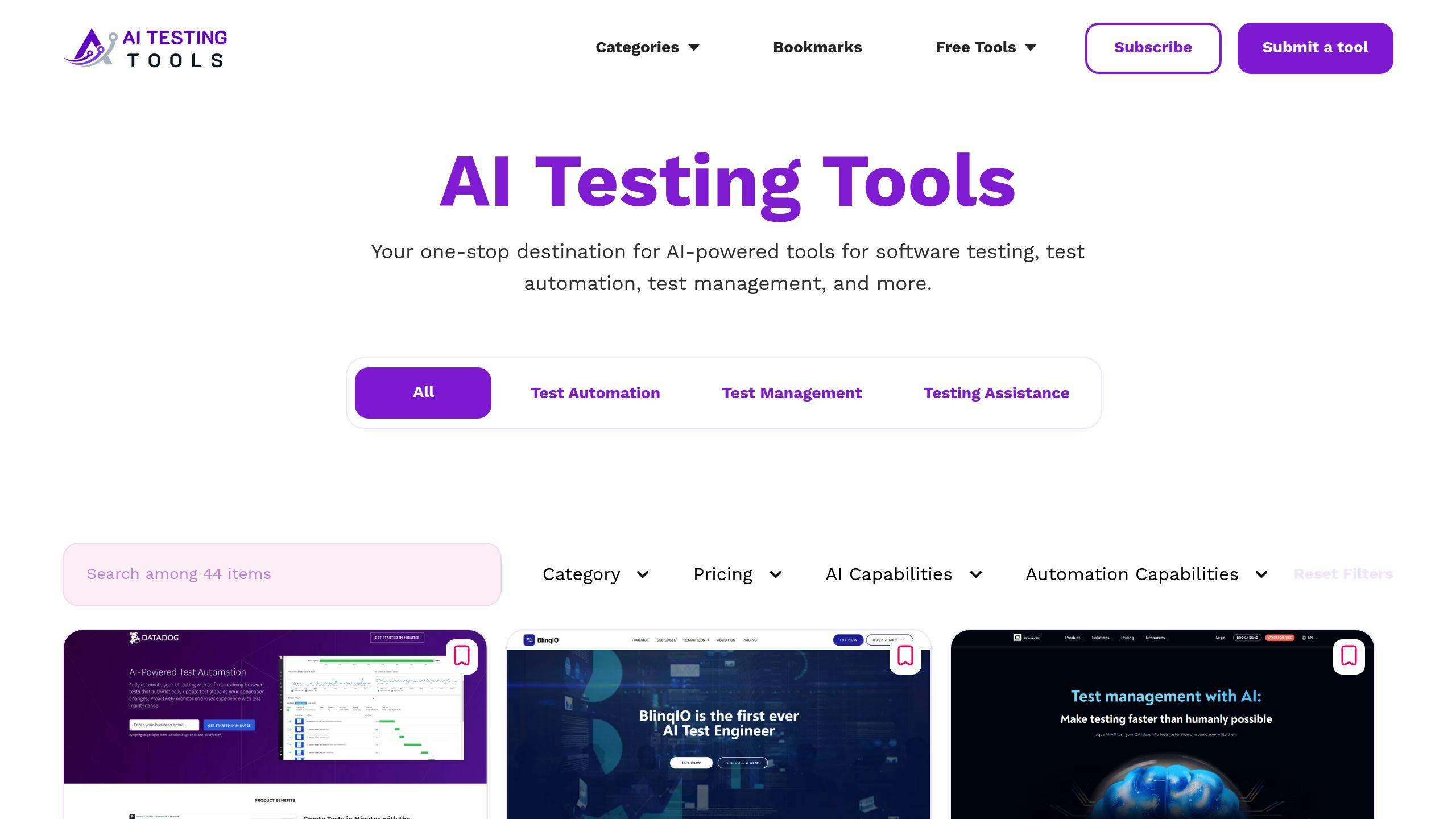Building a scalable test automation framework ensures your testing process remains efficient and manageable as your project grows. Here's what you need to know:
- Why It Matters: Scalability reduces manual work, optimizes resources, and maintains consistent quality even as test complexity increases.
- Common Challenges:
- Flaky tests with inconsistent results.
- High maintenance efforts for large test suites.
- Tool integration issues causing compatibility problems.
- Best Practices:
- Use modular and reusable components like Page Object Models (POMs).
- Implement data-driven testing to separate test logic from test data.
- Follow coding standards and maintain clear documentation.
- CI/CD Integration:
- Leverage AI:
- Features like self-healing automation and intelligent analytics reduce maintenance and improve efficiency.
Accelerating Releases by Building and Scaling Test Automation
Best Practices for Designing Scalable Frameworks
Tackling flakiness and maintenance challenges starts with smart design principles that support long-term usability and efficiency. By following proven methods, teams can build frameworks that adapt to growing testing demands without piling on technical debt.
Focus on Modular and Reusable Components
Breaking your framework into smaller, independent pieces is a game-changer. Modular design allows you to create reusable components that are easy to maintain and update. A great example of this is Page Object Models (POMs), which organize web page elements and actions into separate classes. This setup simplifies updates when the app's interface changes. Similarly, centralizing common utilities like login handlers ensures consistency and reduces redundancies.
This modular approach also works well with data-driven testing, making your framework even more efficient.
Leverage Data-Driven Testing
Separating test data from test logic is a smart way to scale your framework. Data-driven testing lets you use the same scripts with different data sets, saving time and effort. Plus, it keeps your core test code intact, reducing maintenance headaches.
Some effective strategies include:
- Storing data externally (like in CSV files or databases)
- Using variable parameterization
- Organizing data in logical structures
These techniques make it easier to expand your test coverage without rewriting everything.
Stick to Coding Standards and Documentation
A well-structured framework isn’t enough on its own - it also needs consistency and clear guidelines. Following coding standards improves readability, speeds up onboarding, and keeps technical debt under control. Automated tools can help enforce these standards, while thorough documentation ensures everyone knows how to use and expand the framework.
Integrating Frameworks with CI/CD Pipelines
To keep up with fast-paced development, modern test automation frameworks must work smoothly with CI/CD pipelines. This ensures continuous testing throughout the development process, helping teams catch problems early and maintain high-quality standards. By building on modular design principles, this integration allows testing efforts to grow alongside development speed.
Setting Up Automated Test Execution and Reporting
Automating tests within CI/CD pipelines can speed up feedback loops and improve efficiency. Using containerized environments like Docker and running tests in parallel are key strategies. Tools such as Jenkins and GitLab CI/CD make it easier to automate test execution through built-in integrations.
Here’s what a strong test execution setup should include:
- Environment Configuration: Use tools like Docker to create consistent testing environments across the pipeline.
- Parallel Execution: Run tests simultaneously where possible to save time.
- Smart Test Selection: Prioritize tests based on code changes and potential risk areas.
AI-powered tools like Applitools can also enhance reporting by offering detailed analytics and visualizations, making it easier to act on test results [3].
Best Practices for Version Control and Collaboration
Version control plays a critical role in integrating test automation effectively. Following these practices can ensure smooth collaboration and maintain framework stability:
| Practice | Function | Benefit |
|---|---|---|
| Branch Protection | Blocks unauthorized changes to test code | Keeps the framework stable |
| Code Review Workflow | Promotes quality and consistency | Lowers the risk of technical debt |
| Automated Linting | Enforces coding standards | Makes code easier to maintain |
Using integrated project management tools can further align testing efforts with development goals, ensuring both teams stay on the same page [1].
This foundation of continuous testing prepares teams to explore AI-driven optimizations, as discussed in the next section.
sbb-itb-cbd254e
Using AI for Scalable Test Automation
AI-driven testing tools tackle key challenges in scalability by offering smart features that cut down on maintenance efforts and improve efficiency.
AI Features in Test Automation (and Why They Matter)
AI tools directly address common issues like flaky tests and integration hurdles. A standout feature is self-healing automation, which adjusts to UI changes automatically, eliminating the need for manual updates. For instance, Applitools reports a 62% reduction in maintenance through its AI-powered visual testing capabilities [3].
| Feature | Purpose | Example Tool |
|---|---|---|
| Self-healing Automation | Automatically fixes broken test scripts | Applitools |
| Intelligent Analytics | Predicts failures and optimizes test coverage | Functionize |
| Visual AI Testing | Conducts thorough UI validation | Applitools |
How AI Improves Scalability and Maintenance
AI transforms test automation by making it more scalable and easier to maintain. For example, Functionize uses AI to run tests across various browsers and devices in just minutes, addressing the scalability challenges highlighted earlier [3].
Here are some key advantages:
- Smart Test Management: Automates test creation and prioritizes tests based on risk.
- Intelligent Error Detection: Identifies root causes and predicts potential failures.
- Automated Maintenance: Self-healing features reduce the need for manual intervention.
AI Testing Tools Directory

This directory simplifies the process of finding the right tools by categorizing them based on:
- Test types (automation, management, data)
- Pricing options (open-source, freemium, paid)
- Automation capabilities (web, mobile, API)
- AI features (self-healing, visual testing, test generation)
Maintaining and Optimizing Frameworks
Keeping test automation frameworks in top shape demands regular upkeep and smart improvements to ensure they stay effective and scalable over time.
Regular Refactoring and Code Reviews
Frequent code reviews and refactoring help maintain the framework's quality and prevent technical debt from piling up.
Here are some practices that can make code reviews more effective:
| Practice | Purpose | Impact |
|---|---|---|
| Pair Programming | Enables real-time code review and knowledge sharing | Cuts down bugs and boosts code quality |
| Scheduled Reviews | Provides regular checks on framework components | Highlights redundancies and areas for improvement |
| CI/CD Integration | Automates code quality checks | Maintains consistent coding standards |
Implementing Error Handling and Logging
Strong error handling and logging systems play a big role in resolving issues quickly and ensuring framework reliability.
Key elements of effective error handling include:
- Detailed error reports with timestamps for better context.
- Tiered logging levels, ranging from DEBUG to ERROR, for better organization.
- Centralized log analysis tools linked to CI/CD systems for complete visibility.
These practices also work hand-in-hand with AI-powered analytics by providing raw data for smarter failure analysis.
Updating Frameworks for Changing Needs
As testing needs evolve, frameworks must adapt without disrupting ongoing activities. A well-thought-out strategy ensures smooth transitions.
Some effective adaptation strategies include:
- Regularly assessing new technologies through resources like the AI Testing Tools Directory.
- Updating frameworks in modular components to minimize disruptions.
- Providing continuous training to your team to keep everyone aligned with updates.
Conclusion: Key Points for Scalable Test Automation
Effective scalable test automation frameworks merge technical precision with AI-driven processes. Research highlights that such frameworks can cut test execution time by 90% while doubling test coverage [2]. Additionally, incorporating AI reduces test creation time by 70% and enhances defect detection by 45% [3].
| Framework Component | Contribution to Scalability |
|---|---|
| Modular Design | Easier maintenance |
| AI Integration | Greater efficiency |
| CI/CD Pipeline | Streamlined execution |
| Data-Driven Approach | Broader test coverage |
Final Thoughts
To maintain scalable frameworks, teams must blend established techniques with new technologies. By combining modular designs with AI's evolving capabilities, teams can create systems that grow with their testing requirements. These approaches build on the crucial principles of error handling and documentation covered earlier, fostering reliable and efficient test automation.
For those seeking to enhance their frameworks with AI, the AI Testing Tools Directory remains a helpful resource. It underscores the importance of integrating trusted methods with forward-thinking solutions to succeed in modern test automation.
FAQs
What is scalability in an automation framework?
Scalability in test automation frameworks refers to their ability to handle increasing testing demands without losing efficiency. It ensures that as your testing needs grow, the framework remains effective and manageable. Here are some of the key features that contribute to scalability:
- Modular architecture: Allows updates to be made independently without disrupting the entire system.
- Data-driven design: Simplifies maintenance and improves flexibility.
- AI integration: Automates routine maintenance tasks and adapts to changes.
A scalable framework focuses on several important aspects:
| Key Aspect | How It Supports Scalability |
|---|---|
| Framework Design | Handles larger test suites without slowing down |
| Resource Management | Ensures efficient execution of expanding test cases |
| Maintenance Simplicity | Minimizes time spent on updates and adjustments |
| Tool Compatibility | Works seamlessly with new tools and AI technologies |
These elements highlight how modern frameworks can grow alongside testing requirements while keeping maintenance manageable and performance consistent.



